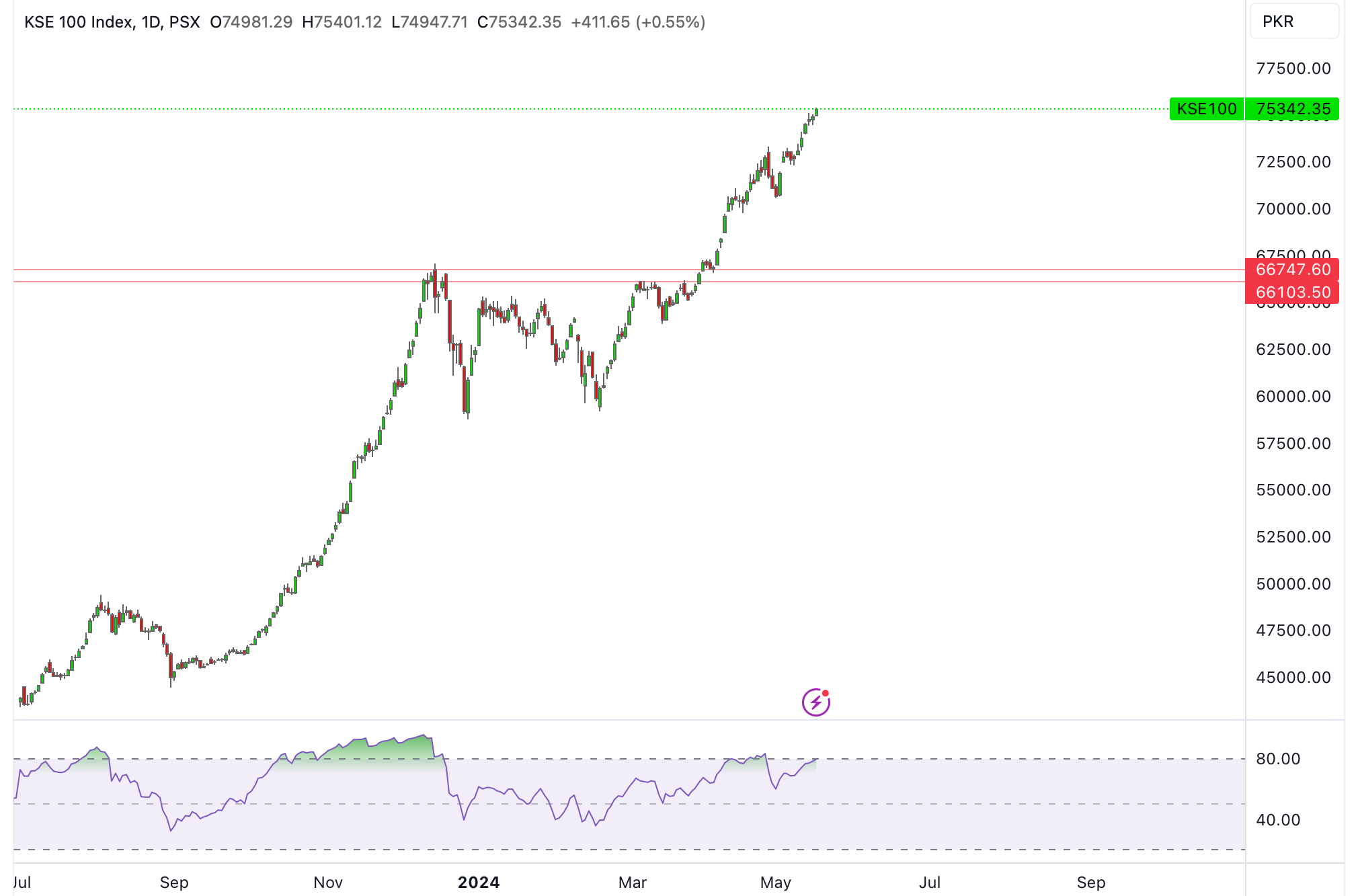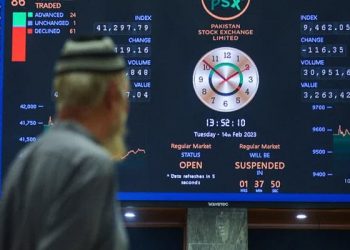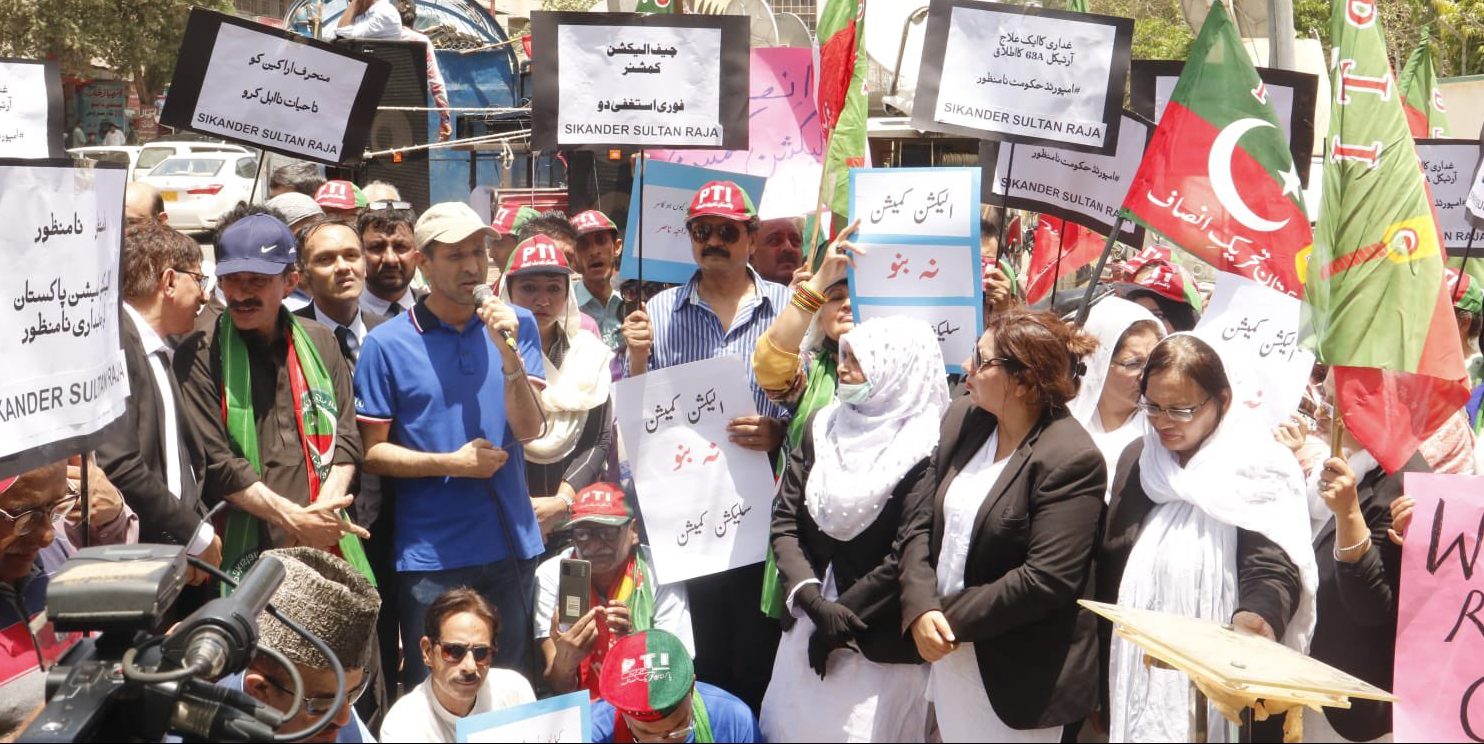HERE’S A WEEKLY BUSINESS NEWS ROUNDUP FOR PAKISTAN AS OF MID-MAY 2024:
PAKISTAN STOCK MARKET CONTINUES HISTORIC BULL RUN, KSE-100 INDEX HITS RECORD HIGH
The Pakistan Stock Exchange (PSX) witnessed a remarkable performance this week, with the benchmark KSE-100 index surging by 2,257 points or 3.1%, closing at a record high of 75,342 points. This impressive gain reflects ongoing positive sentiment and strong foreign investment in the market.
Currency Movement
On the currency front, the Pakistani Rupee experienced a marginal week-on-week decline of 0.03%. Despite this slight dip, the overall market sentiment remained robust, with the KSE-100 index showing consistent strength.
Market Trading Dynamics
Throughout the week, the KSE-100 index traded within a range of 2,291 points, hitting a high of 75,401 points and a low of 73,110 points. This trading range indicates significant investor activity and confidence in the market’s upward trajectory.
In terms of volume, the PSX recorded an average traded volume of 554.51 million shares, valued at Rs21.93 billion. This represents a decrease of 22.7% in the number of shares traded and a 10.4% drop in traded value week-on-week. Despite the reduced volume, the market capitalization saw a notable increase.
Market Capitalization
The PSX market capitalization grew by $906.84 million or 2.6%, reaching $36.42 billion over the week. In Pakistani Rupee terms, the market capitalization stood at Rs10.13 trillion. This increase underscores the strong investor confidence and the overall positive economic outlook.
Drivers of Market Performance
The ongoing bull run in the Pakistan stock market, which began last year following the International Monetary Fund (IMF) loan deal, has been further bolstered by several factors:
- Strong Foreign Buying Spree: Foreign investors have shown significant interest in the Pakistani market, contributing to its upward momentum.
- Interest Rate Cut Expectations: Improved economic conditions have led to renewed bets on potential interest rate cuts, enhancing market optimism.
- Talks of New IMF Program: Official discussions for a new IMF program have added to the positive sentiment, with investors anticipating further economic stability and support.
TOP INDEX MOVERS
Positive Contributors:
- Commercial Banks: Contributed 1,038 points
- Oil & Gas Exploration Companies: Contributed 417 points
- Fertilizer: Contributed 239 points
- Inv. Banks / Inv. Cos. / Securities Cos.: Contributed 152 points
- Automobile Parts & Accessories: Contributed 141 points
Negative Contributors:
- Cable & Electrical Goods: Deducted 25 points
- Oil & Gas Marketing Companies: Deducted 13 points
- Textile Composite: Deducted 8 points
- Insurance: Deducted 6 points
- Transport: Deducted 5 points
BEST-PERFORMING STOCKS
Top Performers:
- UBL: Gained 295 points
- POL: Gained 202 points
- MCB: Gained 174 points
- EFERT: Gained 174 points
- MEBL: Gained 173 points
Underperformers:
- TRG
- PAEL
- KEL
- PSO
- FCCL
FOREIGN INVESTMENT
Net Buying:
- Foreign investors were net buyers, acquiring $14.94 million worth of equities during the week.
- Foreign corporations dominated buying with a net investment of $17 million.
- They allocated the majority of capital to Commercial Banks, with $7.79 million invested.
- Significant sales activity was observed in the Banks / Dfi sector, with a net sale of $9.85 million.
Index Performance
- The 100-index has gained 33,890 points or 81.76% during the fiscal year.
- In the ongoing calendar year, there has been a cumulative increase of 12,891 points, equivalent to 20.64%.
IMF PAKISTAN PUSH
The International Monetary Fund (IMF) has approved a $3 billion, 9-month Stand-By Agreement (SBA) for Pakistan, with an immediate disbursement of $1.2 billion to aid in economic stabilization. The remaining funds will be disbursed in phases, contingent on successful quarterly reviews. This approval follows a Staff Level Agreement (SLA) signed on June 29, 2023, aimed at addressing immediate economic stabilization needs, protecting against external shocks, and facilitating social and development spending to benefit the population. Pakistan’s economic reform program is critical due to a challenging external environment, severe floods, and policy missteps, which have resulted in large fiscal and external deficits, rising inflation, and eroded reserve buffers in FY23.
Expert commentary underscores the significance of the IMF loan, emphasizing that it provides much-needed stability during a governmental transition and aids in securing further financial support. Additionally, Pakistan has recently received substantial financial aid, including a $2 billion deposit from Saudi Arabia and a $1 billion deposit from the UAE, bringing total reserves to $9.75 billion as of June 30, 2023. This combined financial support aims to bolster foreign exchange reserves and stabilize currency and inflationary pressures, offering a crucial buffer for the country’s economy.
PAKISTAN’S ECONOMIC FRONT: CURRENT ACCOUNT SURPLUS AND RECORD FDI BOOST GROWTH PROSPECTS
Pakistan’s economy continues to show promising signs of recovery, marked by significant milestones in key economic indicators. The country posted another current account surplus of $491 million, driven largely by a substantial increase in workers’ remittances. This surplus highlights the positive impact of remittances on the country’s balance of payments and overall economic stability.
Foreign Direct Investment Surge
In April 2024, Pakistan attracted $359 million in foreign direct investment (FDI), the highest in over four years. This surge in FDI reflects growing investor confidence and the country’s improving economic environment. The influx of foreign capital is expected to bolster economic growth and create new opportunities across various sectors.
Inflation and Economic Growth
Economic growth in Pakistan is on an upward trajectory, with inflationary pressures easing. Weekly inflation fell for the fifth consecutive week, signaling a downward trend. Consequently, the Consumer Price Index (CPI)-based inflation for May is projected to decline to around 13-14% year-on-year. This decrease in inflation is expanding real interest rates to 8-9%, providing a more favorable environment for investment and consumption.
Government Auctions and Monetary Policy
The government successfully conducted two auctions during the week, raising Rs639.5 billion through Market Treasury Bills (MTBs) at lower yields, and Rs458.5 billion through Pakistan Investment Bonds (PIB)-PFL auction. The central bank’s decision to decrease the cut-off yields for 12-month Treasury Bills by 49 basis points further strengthens expectations for a rate cut in June’s monetary policy meeting. Lower yields and the potential rate cut are likely to stimulate economic activity by reducing borrowing costs for businesses and consumers.
PAKISTAN’S ECONOMIC INDICATORS SHOW ROBUST IMPROVEMENT WITH CURRENT ACCOUNT SURPLUS AND RISING EXPORTS
Pakistan’s economic landscape continues to show promising signs of improvement, according to the latest data released by the State Bank of Pakistan (SBP). Key indicators such as the current account balance, trade figures, and workers’ remittances reflect a positive trajectory for the country’s economy.
Current Account Surplus
In April 2024, Pakistan recorded a current account surplus of $491 million. This marks a consistent upward trend following a surplus of $434 million in March 2024 and $134 million in April 2023. The cumulative current account deficit for the first ten months of the fiscal year 2024 (10MFY24) stands at $202 million, a remarkable 94.8% improvement year-on-year (YoY) compared to a deficit of $3.92 billion in the same period of the previous fiscal year.
Trade Balance
Exports:
- Total exports rose by 22.0% YoY to $3.28 billion in April 2024, up from $2.69 billion in April 2023.
- Month-on-month (MoM), exports saw a modest increase of 1.6% from $3.23 billion in March 2024.
Imports:
- Total imports increased by 21.5% YoY to $5.28 billion, compared to $4.35 billion in April 2023.
- MoM, imports decreased by 2.7% from $5.42 billion in March 2024.
Trade Deficit:
- The trade deficit in goods and services for April 2024 rose 20.6% YoY to $2 billion.
- On a monthly basis, the trade deficit narrowed by 9.0%.
Detailed Breakdown:
- Goods: The trade deficit in goods was $1.81 billion, reflecting a 21.9% YoY increase and an 11.3% MoM decrease. This was driven by a 23.4% YoY rise in exports and a 22.8% YoY increase in imports.
- Services: The trade deficit in services stood at $187 million, up 9.4% YoY and 22.2% MoM.
Workers’ Remittances
Workers’ remittances in April 2024 rose significantly by 27.9% YoY to $2.81 billion from $2.2 billion in April 2023. However, they experienced a slight decline of 4.8% MoM from $2.95 billion in March 2024. Cumulatively, in 10MFY24, remittances totaled $23.85 billion, marking a 3.5% increase YoY from $23.04 billion in the same period last fiscal year.
PAKISTAN’S FOREIGN DIRECT INVESTMENT (FDI) SOARS IN APRIL 2024
Pakistan has witnessed a significant surge in Foreign Direct Investment (FDI) in April 2024, recording an inflow of $358.84 million, according to the latest data released by the State Bank of Pakistan (SBP). This represents a dramatic increase compared to the $131.9 million reported in the same period last year (SPLY).
MONTHLY AND CUMULATIVE COMPARISON
Month-on-Month Comparison:
- April 2024: $358.84 million
- March 2024: $258.04 million
Year-on-Year Comparison:
- April 2024: $358.84 million
- April 2023: $131.9 million
Cumulative FDI in 10MFY24:
- 10MFY24: $1.46 billion
- 10MFY23: $1.35 billion
Detailed Breakdown of Direct Investments
In April 2024, direct investment inflows surged to $414.04 million, marking a 133.79% increase YoY. The outflows also increased to $55.21 million, up by over 22.15% YoY. This indicates a net positive inflow contributing to the overall FDI figures.
Portfolio Investment under FDI
Portfolio investments, particularly through equity securities, saw an inflow of $16.31 million in April 2024, compared to $6.12 million in April 2023. This marks a substantial increase in investor confidence and participation in Pakistan’s equity market.
Foreign Private and Public Investments
Foreign Private Investment:
- April 2024: Positive $375.14 million
- April 2023: $138.02 million
Foreign Public Investment:
- An outflow of $979.85 million was recorded in April 2024 through equity securities.
Overall, the total foreign divestment in April 2024 stood at $604.71 million, compared to an investment of $139.17 million in April 2023. This significant divestment reflects a dynamic and shifting investment landscape.
Cumulative Foreign Investment
Within the first ten months of FY24, total foreign investment amounted to $659.26 million, compared to $341.39 million in the corresponding period last year. This indicates a considerable increase in foreign investment inflows, underscoring improved investor sentiment and confidence in Pakistan’s economic prospects.
PAKISTAN’S WEEKLY SENSITIVE PRICE INDICATOR (SPI) SHOWS CONTINUED DECLINE
The Weekly Sensitive Price Indicator (SPI) for the Combined Group in Pakistan recorded a decrease of -1.06% week-on-week (WoW) for the week ending May 16, 2024, according to the latest data released by the Pakistan Bureau of Statistics (PBS). This marks the fifth consecutive weekly decline in SPI.
Key Highlights
- Week-on-Week Change: -1.06%
- Year-on-Year Change: +21.22%
- Current Combined Index: 309.25
- Previous Week’s Index: 312.56
- Index a Year Ago: 255.12
Price Movements
Out of the 51 items monitored, the prices showed the following trends:
- Increased Prices: 20 items (39.22%)
- Decreased Prices: 16 items (31.37%)
- Stable Prices: 15 items (29.41%)
Major Decreases:
- Tomatoes: -31.18%
- Onions: -21.84%
- Garlic: -7.76%
- Wheat: -5.48%
- Petrol: -5.32%
Major Increases:
- Cooked Daal: +1.96%
- Shirting: +1.74%
- Potatoes: +1.46%
- Beef: +1.11%
- Mutton: +1.04%
Income Group Analysis
The weekly SPI percentage change across different income groups showed a uniform decrease ranging between -1.02% and -1.17%.
- Lowest Income Group: -1.17%
- Highest Income Group: -1.06%
On a yearly basis, SPI increased for all income groups, with variations between 14.54% and 24.58%.
- Lowest Income Group: +14.54%
- Highest Income Group: +19.07%
Commodity Prices
- Sona Urea: The average price per 50 kg bag stood at Rs4,839, marking a slight increase of 0.06% WoW and a significant rise of 56.44% YoY.
- Cement: The average price per 50 kg bag was recorded at Rs1,210, reflecting an increase of 0.55% WoW and 8.62% YoY.
SBP AUCTION RESULTS: MARKET TREASURY BILLS WORTH RS639.52 BILLION SOLD
In a significant move to manage liquidity and interest rates, the State Bank of Pakistan (SBP) conducted an auction on Wednesday, successfully selling Market Treasury Bills (MTBs) worth Rs639.52 billion. The auction targeted three maturities: 3 months, 6 months, and 12 months, against a set target of Rs450 billion.
Key Auction Results
- Total Amount Offered: Rs1.88 trillion
- Total Amount Accepted: Rs639.52 billion
- Auction Target: Rs450 billion
Cut-Off Yields
- 3 Months: 21.5973% (down 6 basis points)
- 6 Months: 21.2899% (down 10 basis points)
- 12 Months: 20.4052% (down 49 basis points)
Bids Received and Accepted
- 3 Months:
- Bids Received: Rs312.4 billion
- Bids Accepted: Rs160.82 billion
- 6 Months:
- Bids Received: Rs438.55 billion
- Bids Accepted: Rs318.87 billion
- 12 Months:
- Bids Received: Rs1.13 trillion
- Bids Accepted: Rs77 billion
In addition to the competitive auction, the SBP also picked up Rs82.83 billion from the non-competitive auction, bringing the total accepted amount to Rs639.52 billion.
Bid-to-Cover Ratio
The bid-to-cover ratio, which measures the total amount of bids received versus the amount sold, stood at 2.94, down from 3.52 in the previous auction. This indicates that the SBP accepted approximately 33.99% of the total bids it received.
Previous Auction Comparison
In the last auction held on April 30, 2024, the SBP sold MTBs worth Rs253 billion against a target of Rs300 billion. The cut-off yields for that auction were:
- 3 Months: 21.6601%
- 6 Months: 21.3874%
- 12 Months: 20.8989%
ANALYSIS
The results of this auction highlight a continued effort by the SBP to manage the yield curve and control inflationary pressures. The fall in cut-off yields across all maturities indicates a slight easing in the cost of borrowing, reflecting market expectations of stable or improving economic conditions. The high bid-to-cover ratio suggests robust demand for government securities, albeit lower than the previous auction, possibly due to investor adjustments based on evolving economic signals.
The acceptance of a significant portion of non-competitive bids also underscores the SBP’s strategic approach to ensure adequate liquidity in the market while maintaining a cautious stance on interest rates.
SUCCESSFUL AUCTION: PAKISTAN INVESTMENT BOND – FLOATING RATE (PIB-PFL) SEMIANNUAL
The State Bank of Pakistan (SBP) recently concluded a successful auction, raising significant funds through the sale of Pakistan Investment Bond – Floating Rate (PIB-PFL) semiannual bonds. Here are the key details of the auction:
Auction Details
- Date: Wednesday
- Total Amount Raised: Rs458.53 billion
- Target: Rs280 billion
Bond Maturities and Cut-off Prices
- 5-Year PIB-PFL Semiannual:
- Amount Raised: Rs381.78 billion
- Cut-off Price: Rs96.1823
- 10-Year PIB-PFL Semiannual:
- Amount Raised: Rs76.75 billion
- Cut-off Price: Rs94.2124
Total Bids Received
- PIB-PFL Semiannual: Rs1.33 trillion
- PIB-PFL Quarterly: Rs638.2 million
Allocation and Settlement
- The SBP accepted bids worth Rs458.53 billion for the semiannual floaters and none for the quarterly PIB.
- Settlement date for successful bids: May 16, 2024.
Competitive and Non-competitive Bids
- Competitive Bids: Rs438 billion
- Non-competitive Bids: Rs20.53 billion
Target Comparison
- The target for PIB-PFL semiannual was to raise Rs160 billion through the sale of 5-year and 10-year PIB, Rs80 billion each.
- In the last auction held on April 30, 2024, PIBs-PFL worth Rs194 billion were sold against a target of Rs280 billion.
Previous Auction Comparison
- Cut-off Prices (April 30, 2024):
- 5-Year PIB-PFL Semiannual: 95.8364
- 10-Year PIB-PFL Semiannual: 93.5557
ANALYSIS
The auction results indicate strong demand for PIB-PFL semiannual bonds, with the SBP successfully raising funds above the target amount. The competitive bids exceeded expectations, reflecting investor confidence in the country’s economic outlook. The higher cut-off prices compared to the previous auction suggest improved market sentiment and possibly expectations of rising interest rates in the future.
BTC
The cryptocurrency market is witnessing a notable surge in Bitcoin (BTC) trading activity, marked by a bullish bias that has defied expectations during the traditionally subdued weekend trading period. Breaking through a pivotal resistance level, Bitcoin’s upward momentum has triggered a flurry of liquidations across the market. This surge in trading activity underscores the resilience of Bitcoin and highlights the dynamic nature of cryptocurrency markets, where shifts in sentiment can swiftly impact trading patterns and investor behavior.
GOLD
The price of gold in Pakistan saw a notable decline on Friday, with both per tola and per 10 grams prices of 24 karat gold experiencing a decrease. Per tola, the price dropped by Rs 600 to Rs 245,000, while per 10 grams fell by Rs 514, settling at Rs 210,048. This shift in gold prices aligns with broader trends in the global market, where the price of gold, represented by XAU/USD, is exhibiting a bearish bias. Despite earlier bullish movements fueled by softer-than-expected US inflation data for April, which sparked speculation of potential rate cuts from the US Federal Reserve (Fed), recent cautious remarks from Fed officials have tempered these expectations. Emphasizing the necessity of maintaining high borrowing costs for an extended period, these comments have bolstered the US Dollar (USD) and consequently pressured the price of gold downwards, as higher interest rates diminish the attractiveness of non-yielding assets like gold for investors.




















